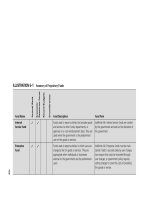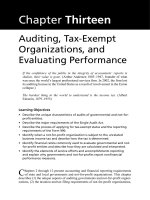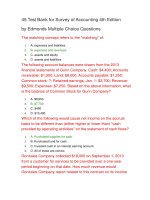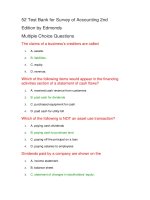45 test bank for survey of accounting 4th edition
Bạn đang xem bản rút gọn của tài liệu. Xem và tải ngay bản đầy đủ của tài liệu tại đây (36.36 KB, 12 trang )
45 Test Bank for Survey of Accounting 4th Edition
by Edmonds Multiple Choice Questions
The matching concept refers to the "matching" of:
1.
A. expenses and liabilities
2.
B. expenses and revenues
3.
C. assets and equity
4.
D. assets and liabilities
The following account balances were drawn from the 2013
financial statements of Gunn Company. Cash: $4,400; Accounts
receivable: $1,500; Land: $8,000. Accounts payable: $1,250;
Common stock: ?; Retained earnings, Jan. 1: $2,700; Revenue:
$9,500; Expenses: $7,250. Based on the above information, what
is the balance of Common Stock for Gunn Company?
1.
A. $9,950
2.
B. $7,700
3.
C. $450
4.
D. $10,400
Which of the following would cause net income on the accrual
basis to be different than (either higher or lower than) "cash
provided by operating activities" on the statement of cash flows?
1.
A. Purchased supplies for cash.
2.
B. Purchased land for cash.
3.
C. Invested cash in an interest earning account.
4.
D. All of these are correct.
Gonzales Company collected $18,000 on September 1, 2013
from a customer for services to be provided over a one-year
period beginning on that date. How much revenue would
Gonzales Company report related to this contract on its income
statement for the year ended December 31, 2013? How much
would it report as cash flows from operating activities for 2013?
1.
A. $6,000; $6,000
2.
B. $6,000; $18,000
3.
C. $18,000; $18,000
4.
D. $0; $18,000
Which of the following correctly states the proper order of the
accounting cycle?
1.
A. Record transactions, adjust accounts, prepare statements, close
temporary accounts.
2.
B. Adjust accounts, record transactions, close temporary accounts, prepare
statements.
3.
C. Prepare statements, record transactions, close temporary accounts,
adjust accounts.
4.
D. Adjust accounts, prepare statements, record transactions, close
temporary accounts.
Franklin Trash Removal Company received a cash advance of
$9,000 on December 1, 2013 to provide services during the
months of December, January, and February. The year-end
adjustment to recognize the partial expiration of the contract will
1.
A. increase equity by $3,000
2.
B. increase assets by $3,000
3.
C. increase liabilities by $3,000
4.
D. Increase Equity by $3,000 and assets by $3,000.
Expenses that are matched with the period in which they are
incurred are frequently called:
1.
A. market expenses
2.
B. matching expenses
3.
C. period costs
4.
D. working costs
Which of the following events would not require an end-of-year
adjusting entry?
1.
A. Purchasing supplies for cash
2.
B. Providing services on account
3.
C. Purchasing a 12-month insurance policy on July 1
4.
D. All of these would require an end-of-year adjustment
Norris Company experienced the following transactions during
2013, its first year in operation. 1. Issued $6,000 of common stock
to stockholders; 2. Provided $2,300 of services on account; 3.
Paid $1,600 cash for operating expenses; 4. Collected $1,900 of
cash from accounts receivable; 5. Paid a $100 cash dividend to
stockholders. The amount of net income recognized on Norris
Company's 2013 income statement is:
1.
A. $500.
2.
B. $400.
3.
C. $700.
4.
D. $600.
Which of the following accounts is not closed at the end of an
accounting cycle?
1.
A. Liabilities
2.
B. Revenues
3.
C. Dividends
4.
D. Expenses
Which of the following is a claims exchange transaction?
1.
A. Purchased machine for cash.
2.
B. Issued common stock.
3.
C. Invested cash in an interest earning account.
4.
D. Recognized revenue earned on a contract where the cash had been
collected at an earlier date.
In uncertain circumstances, the conservatism principle guides
accountants to
1.
A. accelerate revenue recognition and delay expense recognition.
2.
B. accelerate expense recognition and delay revenue recognition.
3.
C. recognize expense of prepaid items when payment is made.
4.
D. maximize reported net income.
Revenue on account amounted to $3,000. Cash collections of
accounts receivable amounted to $2,700. Cash paid for expenses
was $2,500. The amount of employee salaries accrued at the end
of the year was $300. Cash flow from operating activities was
1.
A. $200.
2.
B. $300.
3.
C. $500.
4.
D. None of these.
Ruiz Company provided services for $15,000 cash during the
2013 accounting period. Ruiz incurred $12,000 expenses on
account during 2013, and by the end of the year, $3,000 of that
amount had been paid with cash. Assuming that these are the
only accounting events that affected Ruiz during 2013.
1.
A. The amount of net income shown on the income statement is $3,000.
2.
B. The amount of net income shown on the income statement is $9,000.
3.
C. The amount of net loss shown on the income statement is $3,000.
4.
D. The amount of net cash flow from operating activities shown on the
statement of cash flows is $6,000.
The following accounts and balances were drawn from the
records of Hoover Company on December 31, 2013: Cash:
$1,000; Dividends: 500; Land: 800; Accounts payable: 450;
Account receivable: $850; Common stock: 975; Revenue: 800;
Expense: 550. Total assets on the December 31, 2013 balance
sheet would amount to:
1.
A. $3,150.
2.
B. $3,450.
3.
C. $1,800.
4.
D. $2,650.
If retained earnings decreased during the year, and no dividends
were paid, which of the following must be true?
1.
A. Expenses for the year exceeded revenues
2.
B. The company did not have enough cash to pay its expenses
3.
C. Total equity decreased
4.
D. Liabilities increased during the year
Which of the following is an asset exchange transaction?
1.
A. Issued common stock.
2.
B. Accrued salary expense at the end of the accounting period.
3.
C. Recognized revenue earned on a contract where the cash had been
collected at an earlier date.
4.
D. Collected cash on accounts receivable
Norris Company experienced the following transactions during
2013, its first year in operation. 1. Issued $6,000 of common stock
to stockholders; 2. Provided $2,300 of services on account; 3.
Paid $1,600 cash for operating expenses; 4. Collected $1,900 of
cash from accounts receivable; 5. Paid a $100 cash dividend to
stockholders. The amount of retained earnings appearing on
Norris Company's December 31, 2013 balance sheet is:
1.
A. $500.
2.
B. $600.
3.
C. $700.
4.
D. $6,600.
Norris Company experienced the following transactions during
2013, its first year in operation. 1. Issued $6,000 of common stock
to stockholders; 2. Provided $2,300 of services on account; 3.
Paid $1,600 cash for operating expenses; 4. Collected $1,900 of
cash from accounts receivable; 5. Paid a $100 cash dividend to
stockholders. The total amount of assets shown on Norris
Company's December 31, 2013 balance sheet is:
1.
A. $6,200.
2.
B. $6,600.
3.
C. $6,700.
4.
D. None of these.
Recognition of revenue may be accompanied by which of the
following?
1.
A. A decrease in a liability.
2.
B. An increase in a liability.
3.
C. An increase in assets.
4.
D. A decrease in a liability and an increase in assets.
Revenue on account amounted to $4,000. Cash collections of
accounts receivable amounted to $2,300. Expenses for the period
were $2,100. The company paid dividends of $450. Net income
for the period was
1.
A. $200.
2.
B. $1,450.
3.
C. $1,850.
4.
D. $1,900.
Tocca Co. collected a $5,000 cash advance from a customer on
November 1, 2013 for work to be performed over a six-month
period beginning on that date. If the year-end adjustment is
properly recorded, what will be the effect on Tocca's 2013
financial statements?
1.
A. Increase assets and increase liabilities
2.
B. Increase assets and increase revenues
3.
C. Decrease liabilities and increase revenues
4.
D. No effect
The following accounts and balances were drawn from the
records of Hoover Company on December 31, 2013: Cash:
$1,000; Dividends: 500; Land: 800; Accounts payable: 450;
Account receivable: $850; Common stock: 975; Revenue: 800;
Expense: 550. The amount of retained earnings as of January 1,
2014 was:
1.
A. $1,475.
2.
B. $1,800.
3.
C. $975.
4.
D. $1,225.
James Company paid $1,800 for one year's rent in advance
beginning on October 1, 2013. James's 2013 income statement
would report rent expense, and its statement of cash flows would
report cash outflow for rent, respectively, of
1.
A. $1,800; $1,800
2.
B. $450; $1,800
3.
C. $450; $450
4.
D. $300; $1,800
The entry to recognize work completed on unearned revenue
involves which of the following?
1.
A. An increase in assets and a decrease in liabilities
2.
B. An increase in liabilities and a decrease in equity
3.
C. A decrease in assets and a decrease in liabilities
4.
D. A decrease in liabilities and an increase in equity
The purpose of the accrual basis of accounting is to:
1.
A. Report revenue when received.
2.
B. Match revenues and expenses in the proper period.
3.
C. Report expenses when cash disbursements are made.
4.
D. Improve the company's earnings per share.
The following accounts and balances were drawn from the
records of Hoover Company on December 31, 2013: Cash:
$1,000; Dividends: 500; Land: 800; Accounts payable: 450;
Account receivable: $850; Common stock: 975; Revenue: 800;
Expense: 550. The amount of net income shown on the
December 31, 2013 income statement would amount to:
1.
A. $550.
2.
B. $800.
3.
C. $50.
4.
D. $250.
On December 31, 2013, Farrell Co. owed $1,500 in salaries to
employees who had worked during December but would be paid
in January. If the year-end adjustment is properly recorded on
December 31, 2013, what will be the effect of the accrual on the
following items for Farrell?
1.
A. Net income: No effect; Cash flow from operating activities: No effect
2.
B. Net income: Decrease; Cash flow from operating activities: No effect
3.
C. Net income: Increase; Cash flow from operating activities: Decrease
4.
D. Net income: No effect; Cash flow from operating activities: Decrease
The balance in a revenue account at the beginning of an
accounting period will always be
1.
A. equal to the amount of retained earnings for the previous period.
2.
B. last period's ending balance.
3.
C. higher than the previous periods beginning balance.
4.
D. zero.
Which of the following transactions does not involve an accrual?
1.
A. Recording interest earned that will be received in the next period.
2.
B. Recording operating expense incurred but not yet paid.
3.
C. Recording salary expense incurred but not yet paid.
4.
D. Recording the pre-payment of two years' worth of insurance.
Bledsoe Company received $15,000 cash from the issue of stock
on January 1, 2013. During 2013 Bledsoe earned $8,500 of
revenue on account. The company collected $6,000 cash from
accounts receivable and paid $5,400 cash for operating
expenses. Based on this information alone, during 2013.
1.
A. Total assets increased by $24,100.
2.
B. Total assets increased by $600.
3.
C. Total assets increased by $18,100.
4.
D. Total assets did not change.
Olaf Company began 2013 with $600 in its supplies account.
During the year, the company purchased $1,700 of supplies on
account. The company paid $1,500 on accounts payable by year
end. On December 31, 2013, Olaf counted $700 of supplies on
hand. Olaf's financial statements for 2013 would show:
1.
A. $800 of supplies; $100 of supplies expense
2.
B. $700 of supplies; $1,600 of supplies expense
3.
C. $700 of supplies; $1,000 of supplies expense
4.
D. $800 of supplies; $1,700 of supplies expense
Prior to closing, XYZ Company's accounting records showed the
following balances: Retained earnings: %5,600; Service revenue:
7,250; Interest revenue: 600; Salaries expense: 4,100; Operating
expense: 1,150; Interest expense: 300; Dividends: 900. After
closing, XYZ's retained earnings balance would be
1.
A. $5,600.
2.
B. $7,000.
3.
C. $7,900.
4.
D. None of these.
The accounting principle that guides accountants, when faced
with a recognition dilemma, to choose the alternative that
produces the lowest net income is referred to as
1.
A. the matching principle.
2.
B. internal control.
3.
C. conservatism.
4.
D. materiality.
Norris Company experienced the following transactions during
2013, its first year in operation. 1. Issued $6,000 of common stock
to stockholders; 2. Provided $2,300 of services on account; 3.
Paid $1,600 cash for operating expenses; 4. Collected $1,900 of
cash from accounts receivable; 5. Paid a $100 cash dividend to
stockholders. The amount of net cash flow from operating
activities shown on Norris Company's 2013 statement of cash
flows is
1.
A. $200.
2.
B. $300.
3.
C. $700.
4.
D. $600.
Purchasing prepaid rent is classified as a(n):
1.
A. asset source transaction.
2.
B. asset use transaction.
3.
C. asset exchange transaction.
4.
D. claims exchange transaction.
Which of the following financial statement elements is closed at
the end of an accounting cycle?
1.
A. Liabilities
2.
B. Common stock
3.
C. Assets
4.
D. Revenues
The results of the matching process are best reported on which
financial statement?
1.
A. Balance sheet
2.
B. Income statement
3.
C. Statement of changes in stockholders' equity
4.
D. Statement of cash flows
The recognition of an expense may be accompanied by which of
the following?
1.
A. An increase in assets
2.
B. A decrease in liabilities
3.
C. A decrease in revenue
4.
D. An increase in liabilities
Mackie Company provided $25,500 of services on account, and
collected $18,000 from customers during the year. The company
also incurred $17,000 of expenses on account, and paid $15,400
against its payables. As a result of these events.
1.
A. total assets would increase
2.
B. total liabilities would increase
3.
C. total equity would increase
4.
D. all of these are correct
Which of the following is an asset source transaction?
1.
A. Issued common stock.
2.
B. Paid a cash dividend to stockholders.
3.
C. Received a payment on accounts receivable.
4.
D. Accrued salary expense.
Earning revenue on account would be classified as a/an:
1.
A. claims exchange transaction.
2.
B. asset source transaction.
3.
C. asset use transaction.
4.
D. asset exchange transaction.
Which of the following is an asset use transaction?
1.
A. Purchased machine for cash.
2.
B. Recorded supplies expense at the end of the period.
3.
C. Invested cash in an interest earning account.
4.
D. Accrued salary expense.
Which of the following statements is true in regard to accrual
accounting?
1.
A. Revenue is recorded only when cash is received.
2.
B. Expenses are recorded when they are incurred.
3.
C. Revenue is recorded in the period when it is earned.
4.
D. Expenses are recorded when they are incurred and revenue is recorded
in the period when it is earned.
Which of the following accounts would not appear on a balance
sheet?
1.
A. Unearned Revenue.
2.
B. Salaries Payable.
3.
C. Interest Revenue.
4.
D. Retained Earnings.









